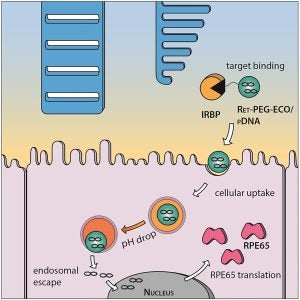Initial testing in animal models holds promise for treating Leber congenital amauroisis and other congenital visual disorders
Researchers at Case Western Reserve University have developed gene-carrying nanoparticles that home in on target cells and prevent vision loss in mice with a human form of Leber congenital amaurosis. The condition is one of the most common causes of blindness in children, according to the National Institutes of Health, affecting two to three of every 100,000 newborns. Though this research focused on the form of the disease called Leber congenital amaurosis 2, or LCA2, the scientists and engineers involved in the study believe the technology holds promise for other forms of LCA as well as other inherited diseases that lead to severe vision loss or blindness. “We believe this technology can deliver almost any type of gene to tackle inherited visual disorders,” said Zheng-Rong Lu, the M. Frank and Margaret Domiter Rudy Professor of Biomedical Engineering at Case Western Reserve and leader of the research. The research team’s study is published in the June 16 issue of Molecular Therapy — Nucleic Acids. Those with LAC2 carry a mutated RPE65 gene and suffer from profound vision loss from birth. The mutated gene fails to produce RPE65 protein in the retinal pigment epithelium (RPE), a cell layer critical for protecting photoreceptors (rods and cones). The protein is an essential constituent of the visual cycle that converts light to electrical signals to the brain.Reaching target cells
 Modified ECO nanoparticles bind to interphotoreceptor retinoid-binding protein (IRBP), which transports them to the target cells in the retinal pigment epithelium (RPE.) The ECO is taken up by the cell through endocytosis but the nanoparticles escape endosomes and release the RPE 65 DNA into the nucleus. The RPE65 gene is now expressed by the RPE call, protecting the photoreceptor cells and preserving vision.
Lu and colleagues designed a lipid-based nanoparticle called ECO to deliver healthy RPE65 genes to RPE cells.
“The promise of this technology is it localizes the drug to the photoreceptor cells, sparing the liver and kidney from exposure,” said Krzysztof Palczewski, chairman of the Department of Pharmacology at the Case Western Reserve School of Medicine. Palczewski, a vision scientist, and Lu, who studies drug delivery, have worked together on this research for six years.
“He had a clever idea,” Palczewski said. “The nanoparticle uses a protein present in the eye to serve as an anchor, and the gene is delivered when bound.”
While other researchers focus on using modified viruses to deliver genes for therapy, sometimes the genes are too large for viruses to carry, Lu said. The ECO can be tailored to fit the cargo.
The exterior of the nanoparticle is coated with nucleic acids that act as targeting agents, drawing the delivery system to the retina and facilitating uptake by RPE cells. To track activity, Lu’s team included a fluorescent marker.
Modified ECO nanoparticles bind to interphotoreceptor retinoid-binding protein (IRBP), which transports them to the target cells in the retinal pigment epithelium (RPE.) The ECO is taken up by the cell through endocytosis but the nanoparticles escape endosomes and release the RPE 65 DNA into the nucleus. The RPE65 gene is now expressed by the RPE call, protecting the photoreceptor cells and preserving vision.
Lu and colleagues designed a lipid-based nanoparticle called ECO to deliver healthy RPE65 genes to RPE cells.
“The promise of this technology is it localizes the drug to the photoreceptor cells, sparing the liver and kidney from exposure,” said Krzysztof Palczewski, chairman of the Department of Pharmacology at the Case Western Reserve School of Medicine. Palczewski, a vision scientist, and Lu, who studies drug delivery, have worked together on this research for six years.
“He had a clever idea,” Palczewski said. “The nanoparticle uses a protein present in the eye to serve as an anchor, and the gene is delivered when bound.”
While other researchers focus on using modified viruses to deliver genes for therapy, sometimes the genes are too large for viruses to carry, Lu said. The ECO can be tailored to fit the cargo.
The exterior of the nanoparticle is coated with nucleic acids that act as targeting agents, drawing the delivery system to the retina and facilitating uptake by RPE cells. To track activity, Lu’s team included a fluorescent marker.





